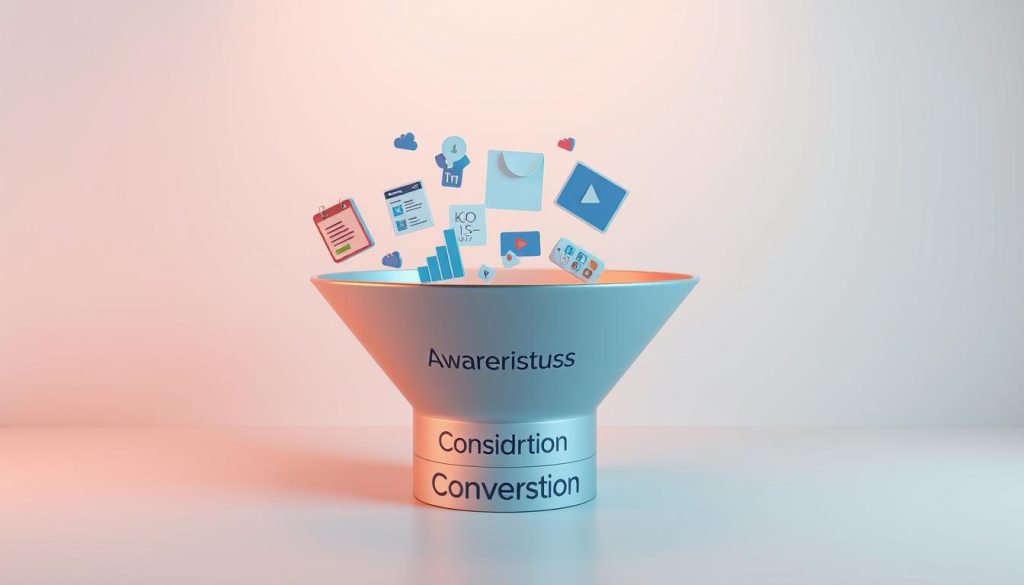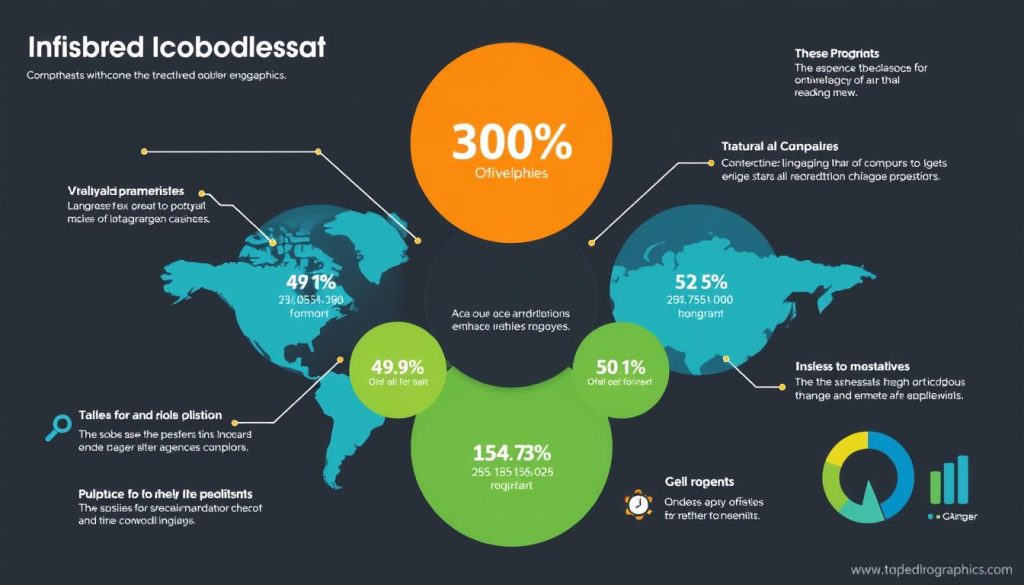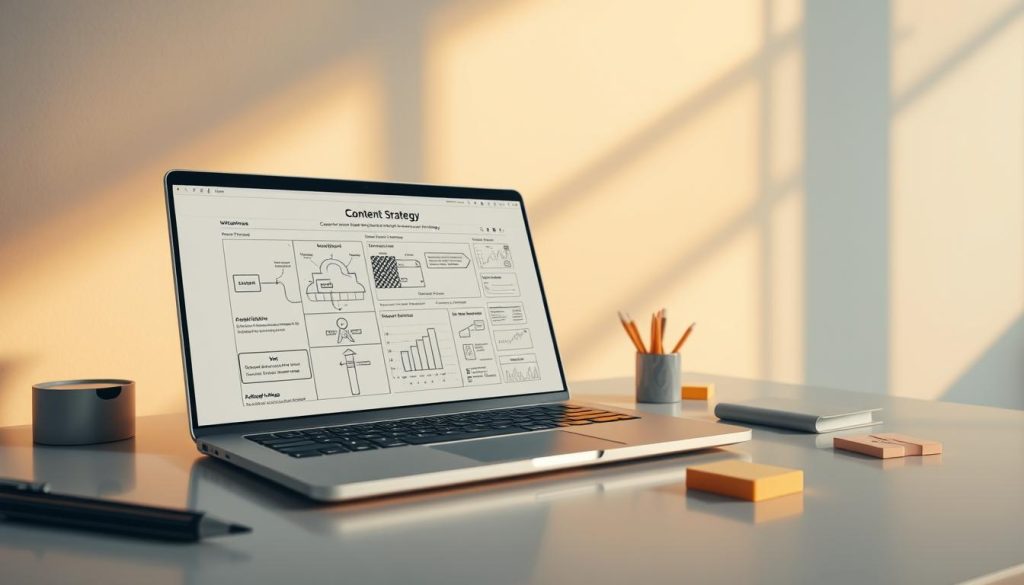We help businesses thrive by guiding potential customers through a carefully crafted customer journey. A well-structured content marketing funnel is crucial for creating predictable revenue growth and transforming casual visitors into loyal customers.
Traditional marketing approaches often fail because they don’t account for the complexities of the customer journey. By understanding your audience’s decision-making process, you can create a tailored experience that resonates at each stage.
This comprehensive guide will break down the essential components of an effective funnel that consistently delivers measurable results. By the end of this guide, you’ll have a clear blueprint for maximizing your ROI and driving sustainable business growth.
Key Takeaways
- Understand how a strategic content marketing funnel can increase ROI.
- Learn the essential components of an effective funnel.
- Discover why traditional marketing approaches often fail.
- Find out how to create content that resonates with your audience.
- Gain a clear blueprint for creating a funnel that drives sustainable business growth.
Understanding the Content Marketing Funnel
The content marketing funnel is a strategic marketing approach that aligns with the customer’s decision-making process. It’s designed to guide potential customers through their buying journey, from initial awareness to the final purchase decision. By understanding and implementing an effective content marketing funnel, businesses can create targeted content that addresses prospects’ needs and nurtures leads through each stage of the decision-making process.

What Is a Content Marketing Funnel?
A content marketing funnel is a structured approach to content creation and distribution that maps the buyer’s journey through various stages. It’s called a “funnel” because it starts with a broad audience at the top and narrows down to the most engaged and converted customers at the bottom. This approach helps businesses provide value, build trust, and guide customers toward choosing their product or service. By aligning content with each stage of the buyer’s journey, businesses can ensure that they’re addressing the specific needs and concerns of their target audience.
The content marketing funnel typically consists of three main stages: top, middle, and bottom. Each stage requires different types of content to effectively engage and nurture leads. Understanding these stages and creating content accordingly is crucial for a successful content marketing strategy.
Why Your Business Needs a Content Marketing Funnel
Implementing a content marketing funnel is essential for businesses that want to maximize their ROI and drive sustainable growth. By focusing on the customer journey rather than just pushing for immediate sales, businesses can build a more meaningful and lasting relationship with their audience. A well-structured content marketing funnel helps businesses align their marketing efforts with the natural decision-making process of their target audience.
Businesses that implement strategic content marketing funnels see higher conversion rates and better ROI compared to those using disconnected content tactics. This is because a content marketing funnel ensures that the right content is delivered to the right people at the right time, maximizing its impact and effectiveness. By understanding and leveraging the content marketing funnel, businesses can create a more cohesive and effective marketing strategy that drives real results.
The Three Stages of an Effective Content Marketing Funnel
To maximize ROI, understanding the three stages of a content marketing funnel is essential. The content marketing funnel is a strategic framework that guides potential customers through the buying process, from initial awareness to conversion.
The funnel is divided into three critical stages: Top of the Funnel (TOFU), Middle of the Funnel (MOFU), and Bottom of the Funnel (BOFU). Each stage serves a unique purpose and requires tailored content to move prospects forward.
Top of the Funnel (TOFU): Awareness Stage
At the top of the funnel, the focus is on creating brand awareness. Top-of-funnel content should introduce your brand and make your audience aware of the problem you’re trying to solve. This stage is about attracting and educating your audience without pushing for immediate sales. We use content marketing strategies to create engaging content that resonates with our target audience.

Middle of the Funnel (MOFU): Consideration Stage
The middle of the funnel is the consideration stage, where potential buyers are familiar with your brand and enter the research phase. At this stage, prospects are actively researching solutions and comparing options, requiring more detailed and comparative content. We develop detailed guides and case studies to help prospects evaluate their options.
Bottom of the Funnel (BOFU): Decision Stage
At the bottom of the funnel, your target persona is the decision-maker. They’re ready to make a purchasing decision but need one final push to decide. This stage requires persuasive, action-oriented content that encourages prospects to become customers. We craft compelling content that drives conversions.
Understanding these three stages is crucial for creating targeted content that moves prospects forward. By aligning your content strategy with the content marketing funnel, you can maximize your ROI and drive business growth.
Mapping Content to the Buyer’s Journey
To maximize the effectiveness of your content marketing funnel, it’s crucial to understand how your audience navigates their buyer’s journey. Throughout my years as a content strategist for B2B SaaS companies, I’ve personally discovered that the buyer’s journey is rarely a straight path.
Most decision-makers begin in an “unaware stage.” They typically fit the demographics of an ideal client or buyer persona, but they’re unaware of the SaaS solution or don’t yet realize they need it. A triggering event often changes their situation or highlights a pain point that needs solving. This is what kicks off their buyer’s journey.
Understanding Your Audience’s Path to Purchase
Identifying your audience’s specific path to purchase is crucial for creating a successful content marketing strategy. Different customer segments may take different routes to conversion, and understanding these variations is key to developing effective content.
To map out your customer’s journey, consider the following:
- How do your customers become aware of their needs?
- What information do they seek during the consideration stage?
- What factors influence their decision-making process?

Aligning Content Strategy with Customer Needs
Once you have a clear understanding of your audience’s path to purchase, you can begin to align your content strategy with their needs. This involves creating content that addresses the specific questions, concerns, and needs your customers have at each stage of their decision-making process.
By providing frameworks for creating content that naturally guides prospects from one stage to the next, you can develop a comprehensive understanding of how your audience makes purchasing decisions. This enables you to create content that directly addresses their needs at exactly the right moment, ultimately maximizing the effectiveness of your content marketing funnel.
Creating High-Impact TOFU Content
Top-of-funnel content plays a vital role in educating and engaging your target audience. At this stage, the goal is to provide value without immediately pushing for sales. Effective TOFU content captures attention, builds awareness, and sets the stage for further nurturing.
Blog Posts and Educational Articles
Blog posts and educational articles are cornerstones of TOFU content. They address common pain points and challenges faced by your target audience, subtly positioning your brand as the solution. To create impactful blog posts, focus on providing actionable insights, industry trends, and practical advice. Some effective ideas include: how-to guides, industry analysis, and thought leadership pieces.

Social Media Content and Videos
Social media content and videos expand your reach and drive traffic to your website. Engaging social media content includes LinkedIn posts sharing quick strategy tips, short videos explaining industry trends, and infographics showcasing key statistics. To maximize impact, tailor your content to each platform’s unique audience and format.
Infographics and Interactive Tools
Infographics and interactive tools simplify complex concepts and provide immediate value to prospects. Infographics are particularly effective for showcasing industry statistics, while interactive tools like quizzes and calculators engage users and encourage sharing. To create compelling infographics, focus on clear visuals, concise messaging, and relevant data.

By incorporating these content types into your TOFU strategy, you’ll be able to attract qualified prospects, build awareness, and establish your brand as a trusted authority in the industry.
Developing Compelling MOFU Content
At the middle of the funnel, prospects are actively researching solutions; it’s here that MOFU content can make a significant impact.
To effectively nurture these prospects, we need to create MOFU content that not only educates but also engages them deeply. This stage is crucial as it builds trust and provides the necessary information for prospects to evaluate their options.
Case Studies and Success Stories
One of the most effective types of MOFU content is case studies and success stories. These real-world examples demonstrate how your product or service has helped other customers achieve their goals.
By highlighting specific challenges, solutions, and results, case studies provide tangible evidence of your offering’s value.
Webinars and Live Demos
Webinars and live demos are another powerful tool in the MOFU stage. They allow prospects to see your solution in action and interact with your team.

When choosing a webinar software for content marketing, consider platforms that offer seamless integration, interactive features, and analytics.
Ebooks, Whitepapers, and Comparison Guides
In-depth resources like ebooks, whitepapers, and comparison guides are invaluable at this stage. They provide detailed information that helps prospects evaluate your offering against competitors.
By addressing specific pain points and showcasing your expertise, these resources can effectively differentiate your product or service.
By incorporating these types of content into your content marketing funnel, you can ensure that your prospects are well-informed and engaged, ultimately moving them closer to a decision.
Crafting Conversion-Focused BOFU Content
Crafting compelling BOFU content is crucial for businesses aiming to maximize their ROI through a well-structured content marketing funnel. At this stage, prospects are ready to make a purchasing decision, and it’s our job to provide the final nudge they need.
The goal of BOFU content is to convert prospects into customers by offering the last piece of information or reassurance they need. This can include free audits, trials, or strategy consultations, testimonials from satisfied customers, live demos, and discounts or coupons.
Leveraging Testimonials and Customer Reviews
Testimonials and customer reviews serve as powerful social proof, removing final doubts and building confidence in our offering. To leverage them effectively, we should:
- Showcase real customer success stories
- Highlight specific benefits and results
- Use authentic, unscripted testimonials
By doing so, we create a sense of trust and credibility, making it easier for prospects to make a purchasing decision.
Creating Effective Free Trials and Product Demos
Free trials and product demos are excellent ways to showcase the value of our product or service. To make them effective, we should focus on:
- Providing hands-on experience
- Highlighting key features and benefits
- Creating a sense of urgency
This approach enables prospects to experience the value firsthand, increasing the likelihood of conversion.
Designing Pricing Pages and Special Offers
Pricing pages and special offers play a critical role in making the purchasing decision clear and compelling. To optimize them, we should:
- Clearly outline pricing and packages
- Highlight the value proposition
- Create limited-time offers
By doing so, we simplify the decision-making process and create a sense of urgency, driving conversions.
To illustrate the effectiveness of different BOFU content strategies, let’s examine the following comparison:
| BOFU Content Strategy | Conversion Rate Impact | Customer Engagement |
|---|---|---|
| Testimonials and Customer Reviews | 25% increase | High trust and credibility |
| Free Trials and Product Demos | 30% increase | Hands-on experience and value realization |
| Pricing Pages and Special Offers | 20% increase | Clear value proposition and urgency |

By incorporating these strategies into our content marketing funnel, we can significantly improve conversion rates and maximize ROI.
Measuring Content Marketing Funnel Performance
The success of your content marketing efforts hinges on accurately measuring your funnel’s performance. Understanding how your funnel performs is critical to identifying areas for improvement and optimizing your marketing strategy.
Key Metrics for Each Funnel Stage
To ensure your content marketing funnel is performing optimally, you need to track key metrics at each stage. At the top of the funnel, metrics such as traffic and bounce rates are crucial. In the middle, conversion rates for webinars or signups are important. At the bottom, demo requests and conversion rates indicate the funnel’s effectiveness.
Leveraging content marketing analytics tools like Google Analytics, HubSpot, or Semrush can help track these metrics. For instance, you can measure blog post views at the top, webinar signups in the middle, and demo requests at the bottom.
Setting Up Tracking and Attribution
Setting up proper tracking and attribution systems is vital to accurately measure the impact of your content marketing efforts. Tools like Hotjar or Crazy Egg can help visualize how users interact with your content, revealing drop-off points and optimization opportunities.
By defining success metrics for each funnel stage and using analytics tools, you can identify bottlenecks in your funnel where prospects are dropping off before conversion. This enables you to create meaningful dashboards and reports that provide actionable insights rather than just vanity metrics.
Optimizing Your Content Marketing Funnel for Better ROI
To maximize ROI, it’s crucial to optimize your content marketing funnel continuously. A well-optimized funnel ensures that your marketing efforts are yielding the best possible results. We will explore advanced strategies that can significantly enhance your funnel’s performance.
A/B Testing Content and CTAs
A/B testing is a powerful method for improving your content marketing funnel. By testing different versions of your content and calls-to-action (CTAs), you can identify what resonates best with your audience. This data-driven approach allows you to make informed decisions that drive better conversion rates.
For instance, you can test different headlines, images, or CTAs on your landing pages to see which version performs better. Tools like HubSpot can help you implement A/B testing effectively.
Personalization Strategies
Personalization is key to making your content marketing funnel more effective. By tailoring your content to the specific needs and behaviors of your audience, you can increase engagement and conversions. Strategies include dynamic content, email personalization, and behavioral targeting.
For example, using tools like HubSpot, you can display dynamic content based on user behavior, such as showing product recommendations after a user views a specific category. Email personalization involves addressing users by name and tailoring email content to their actions.
Retargeting and Nurturing Campaigns
Retargeting and nurturing campaigns are crucial for recapturing the attention of prospects who haven’t yet converted. By using retargeting ads, you can reach users who have visited your site but haven’t taken the desired action. Nurturing campaigns involve sending targeted content to these prospects to guide them back into your funnel.
For retargeting, you can use tools like AdRoll or Google Ads to create campaigns that target users based on their previous interactions with your content. This helps in keeping your brand top-of-mind and encourages prospects to re-engage.
Real-World Examples of Successful Content Marketing Funnels
To understand the effectiveness of content marketing funnels, we’ll explore case studies from both B2B and B2C companies that have driven exceptional results through strategic content marketing.
B2B Content Marketing Funnel Case Study
A prime example of a successful B2B content marketing funnel is HubSpot, a pioneer in inbound marketing. HubSpot’s content strategy is a textbook example of an effective funnel. At the Top of the Funnel (Awareness), HubSpot attracts traffic with educational blog posts and free tools. For instance, their blog post “What Is Inbound Marketing?” and their email signature generator tool help build trust and establish authority in the digital marketing space.
At the Middle of the Funnel (Consideration), HubSpot nurtures leads with in-depth guides, webinars, and whitepapers, such as “The Ultimate Guide to Marketing Automation.” This content educates prospects about specific challenges and demonstrates how HubSpot can solve them. Finally, at the Bottom of the Funnel (Decision), free trials, product demos, and case studies convince prospects to convert. HubSpot’s case studies often highlight measurable results from their tools, such as a company that doubled its leads using their platform.
| Funnel Stage | Content Type | Goal |
|---|---|---|
| TOFU (Awareness) | Educational Blog Posts, Free Tools | Build Trust, Establish Authority |
| MOFU (Consideration) | In-depth Guides, Webinars, Whitepapers | Educate Prospects, Demonstrate Solutions |
| BOFU (Decision) | Free Trials, Product Demos, Case Studies | Convert Leads into Customers |
B2C Content Marketing Funnel Case Study
For B2C companies, a successful content marketing funnel can be seen in brands that focus on building customer loyalty and increasing repeat purchases. By creating highly targeted content, these brands can effectively guide customers through the buyer’s journey. For example, a B2C brand might use social media content and videos at the awareness stage, followed by email nurturing campaigns and special offers at the consideration and decision stages.
By analyzing these real-world examples, businesses can gain actionable insights into creating effective content marketing funnels tailored to their specific needs and industries.

Conclusion: Building a Sustainable Content Marketing Funnel
A content marketing funnel is essential for guiding customers through their journey. By understanding the three stages of an effective content marketing funnel – TOFU, MOFU, and BOFU – businesses can create a cohesive customer journey that drives conversion and boosts ROI.
To achieve sustainable business growth, it’s crucial to continuously measure and optimize your content marketing funnel. This involves tracking key metrics, A/B testing content, and refining your strategy to meet evolving customer needs.
By mastering the content marketing funnel approach, businesses can transform their marketing ROI and create predictable revenue growth. Start building your sustainable content marketing funnel today.
